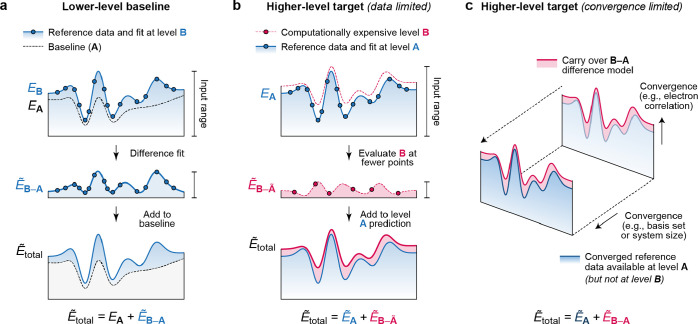Figure 18.
Overview of different approaches to the hierarchical fitting of
potential-energy surface (PES) models. In this figure, the actual
PES are labeled E; fitted models are labeled  ; the indices A and B refer to different types of PES. Drawings are based on the presentation
in ref (164). (a) Using
a lower-level baseline model, which might be a simple analytical term
that only describes certain aspects of the PES (e.g., pair repulsion,
fixed-charge electrostatics, or London dispersion) or a fast semiempirical
method. The baseline model is subtracted from the reference data before
the fit, resulting in a difference model,
; the indices A and B refer to different types of PES. Drawings are based on the presentation
in ref (164). (a) Using
a lower-level baseline model, which might be a simple analytical term
that only describes certain aspects of the PES (e.g., pair repulsion,
fixed-charge electrostatics, or London dispersion) or a fast semiempirical
method. The baseline model is subtracted from the reference data before
the fit, resulting in a difference model,  B–A, to which the baseline model EA is then added back when predictions
are made. (b)
Fitting a higher-level target: for a suitably chosen baseline, the
difference fitting target is smoother (e.g., the range of input data
is smaller, or the difference target varies on a larger length scale),
and therefore fewer reference points are required. Here,
B–A, to which the baseline model EA is then added back when predictions
are made. (b)
Fitting a higher-level target: for a suitably chosen baseline, the
difference fitting target is smoother (e.g., the range of input data
is smaller, or the difference target varies on a larger length scale),
and therefore fewer reference points are required. Here,  in the
subscript of
in the
subscript of  indicates that the fit was made to a potential-energy
difference where the fitting target was obtained by subtracting a fitted model of PES A from the actual PES B. (c) A more complex setup in which convergence (e.g., with
basis set or system size) can be achieved for level A but not for B, which might be because B uses a higher level of treatment for electron correlation and therefore
is more computationally costly.
indicates that the fit was made to a potential-energy
difference where the fitting target was obtained by subtracting a fitted model of PES A from the actual PES B. (c) A more complex setup in which convergence (e.g., with
basis set or system size) can be achieved for level A but not for B, which might be because B uses a higher level of treatment for electron correlation and therefore
is more computationally costly.

